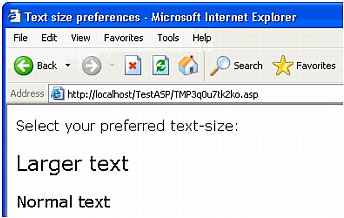Example of information stored in session variables
Example of information stored in session variables
You’re working on a site with a large audience of senior citizens. In Dreamweaver, you add two links to the start page that let users customize the size of the site’s text. For larger, easy-to-read text, the user clicks one link, and for regular-size text, the user clicks another link.

Each link has a URL parameter called fontsize that submits the user’s text preference to the server, as the following Macromedia ColdFusion example shows:
<a href="resort.cfm?fontsize=large">Larger Text</a><br> <a href="resort.cfm?fontsize=small">Normal Text</a>
You decide to store the user’s text preference in a session variable and use it to set the font size on each page the user requests.
Near the top of the destination page, you enter the following code to create a session called font_pref that stores the user’s font size preference.
ColdFusion
<CFSET session.font_pref = url.fontsize>
ASP and ASP.NET
<% Session("font_pref") = Request.QueryString("fontsize") %>
When the user clicks the hypertext link, the page sends the user’s text preference in a URL parameter to the destination page. The code on the destination page stores the URL parameter in the font_pref session variable. For the duration of the user’s session, all the pages of the application retrieve this value and display the selected font size.
Related topics
- Understanding session variables
- Collecting information to store in session variables
- Storing information in session variables
- Retrieving data from session variables
 |  |






